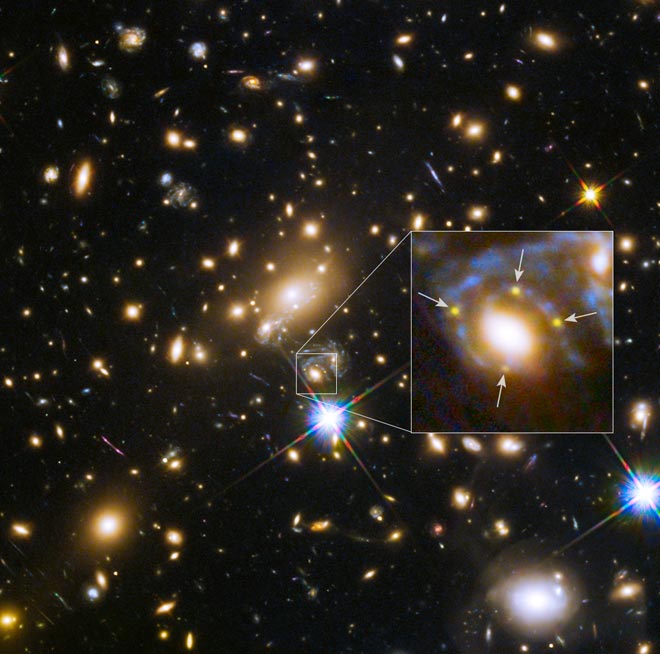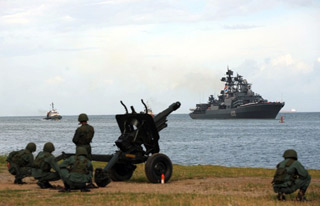
The image shows the galaxy's location within a hefty cluster of galaxies called MACS J1149.6+2223. Arrows (inset) point to the multiple copies of Supernova Refsdal. The four images were spotted on Nov. 11, 2014. Photo: NASA/ESA/STScI/UCLA.
NEW YORK (PTI): Astronomers using NASA's Hubble Space Telescope have spotted for the first time a distant supernova split into four images by cosmic lens.
The multiple images of the exploding star are caused by the powerful gravity of a foreground elliptical galaxy embedded in a massive cluster of galaxies.
This unique observation will help astronomers refine their estimates of the amount and distribution of dark matter in the lensing galaxy and cluster, researchers said.
Dark matter cannot be seen directly but is believed to make up most of the universe's mass.
The gravity from both the elliptical galaxy and the galaxy cluster distorts and magnifies the light from the supernova behind them, an effect called gravitational lensing.
First predicted by Albert Einstein, this effect is similar to a glass lens bending light to magnify and distort the image of an object behind it.
The multiple images are arranged around the elliptical galaxy in a cross-shaped pattern called an Einstein Cross, a name originally given to a particular multiply imaged quasar, the bright core of an active galaxy.
The elliptical galaxy and its cluster, MACS J1149.6+2223, are 5 billion light-years from Earth. The supernova behind it is 9.3 billion light-years away.
Although astronomers have discovered dozens of multiply imaged galaxies and quasars, they have never seen a stellar explosion resolved into several images.
"It really threw me for a loop when I spotted the four images surrounding the galaxy, it was a complete surprise," said Patrick Kelly of the University of California, Berkeley, a member of the Grism Lens Amplified Survey from Space (GLASS) collaboration.
The GLASS group is working with the Frontier Field Supernova (FrontierSN) team to analyse the exploding star.
When the four images fade away, astronomers predict they will have a rare opportunity to catch a rerun of the supernova.
This is because the current four-image pattern is only one part of the lensing display. The supernova may have appeared as a single image some 20 years ago elsewhere in the cluster field, and it is expected to reappear once more within the next five years.
This prediction is based on computer models of the cluster, which describe the various paths the supernova light is taking through the maze of clumpy dark matter in the galactic grouping.
Each image takes a different route through the cluster and arrives at a different time, due, in part, to differences in the length of the pathways the light follows to reach Earth. The four supernova images captured by Hubble, for example, appeared within a few days or weeks of each other.
The finding was published in the journal Science.
 Previous Article
Previous Article Next Article
Next Article













The Indian Air Force, in its flight trials evaluation report submitted before the Defence Ministry l..
view articleAn insight into the Medium Multi-Role Combat Aircraft competition...
view articleSky enthusiasts can now spot the International Space Station (ISS) commanded by Indian-American astr..
view article